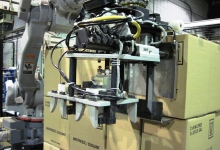
Going Up“This is accomplished by conveying the bottles onto a small elevating platform that lifts the bottles up 12 inches and deposits them onto a channelizing conveyor,” he explains. “A diverter fills two lanes simultaneously, feeding the bottles side-by-side down the channelizing conveyor and into the packaging cell.”
Once sensors signal the robot controller that bottles are in position for pick-up, the robot grabs the bottles two at a time and drops them into a case.
Filled cases then convey underneath the channelizing conveyor through a top-sealing operation and make a U-turn back into the robotic cell on the opposite side of the case-packing station, so that the robot can start palletizing them, with the end-of-arm tool allowing it to switch from case-packing to palletizing without a tooling change.

Photo courtesy of Motoman Robotics
Once the cell control senses that a sealed case is ready for palletizing, explains Winter, the robot temporarily stops case-packing and moves towards filled cases on the opposite side of the cell.
“All the robot actions are completely directed and guided by sensors throughout the conveying line,” says Winter.
“Its controller knows when a filled case needs to be palletized, as well as sensing the arrival of filled bottles.
“So if the filling line should shut down for some reason, the robot will focus on palletizing any remaining filled cases, and then will stand by awaiting the arrival of more filled bottles once the filling line resumes operation.”
The entire workcell is managed simultaneously by two control systems, relates Winter.
“A PLC (programmable logic controller) side controls all of the conveying elements in the cell, while the robot controller (Motoman’s NX100) directs the robot during case-packing and palletizing.”
While one side of the robot’s end-of-arm tool employs pneumatically-actuated mechanical grippers to manipulate the plastic bottles, the opposing size of the tool—used for palletizing—features a small steel plate that slides underneath each packed case.
After a mechanical clamping arm applies downward pressure on the top of each case to ensure a firm grip, the palletizing program stored in the robot control locates the precise assigned position of each case on the 40×48-inch pallets, as specified by one of the four different pre-programmed pallet configurations.
“The robot has all but eliminated any overhang issues, while dramatically increasing our throughput,” Winter states. “We’re running the cell at 10 bottles per minute, or 35 per cent faster than when we packed and palletized manually.
“And we went from three operators required to casepack and palletize on that line to one operator, who only has to monitor
cell activity and keep the caseerector filled with flat cartons,” he adds. ‘The other two
operators, who were earlier reassigned to the line from other areas of the plant when volume picked up, were able to return to their original, less-physically demanding work areas.”
Advertisement

